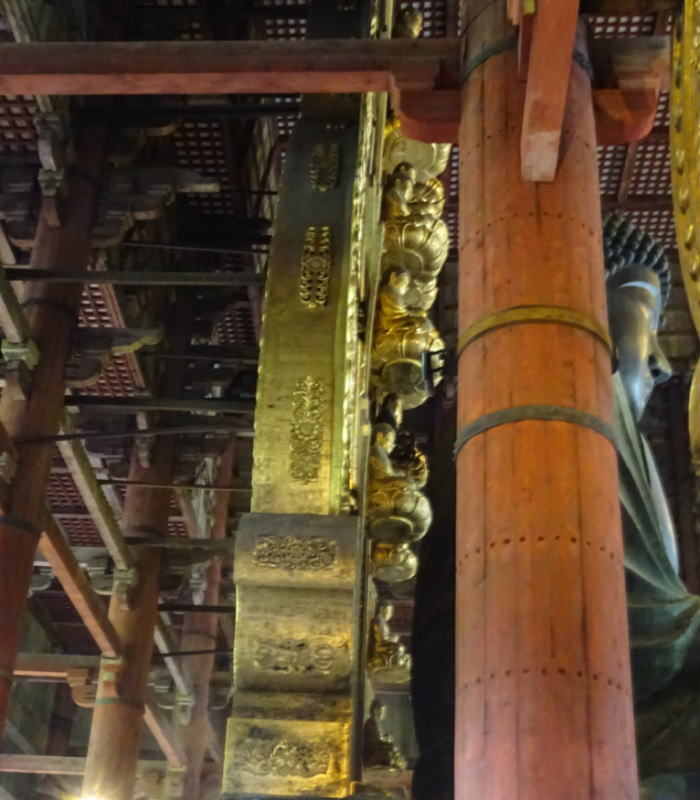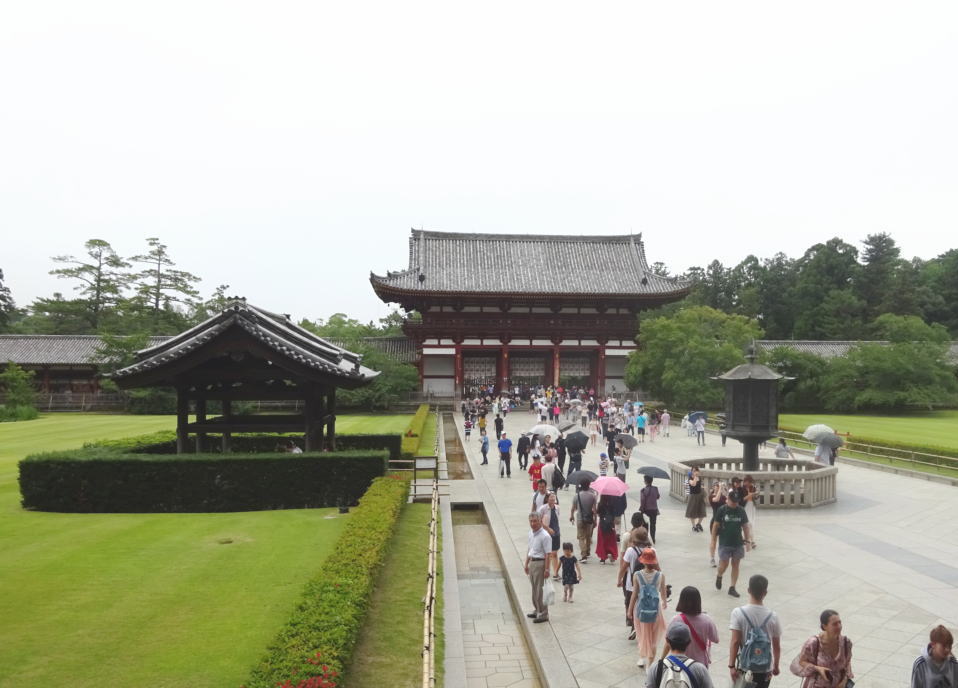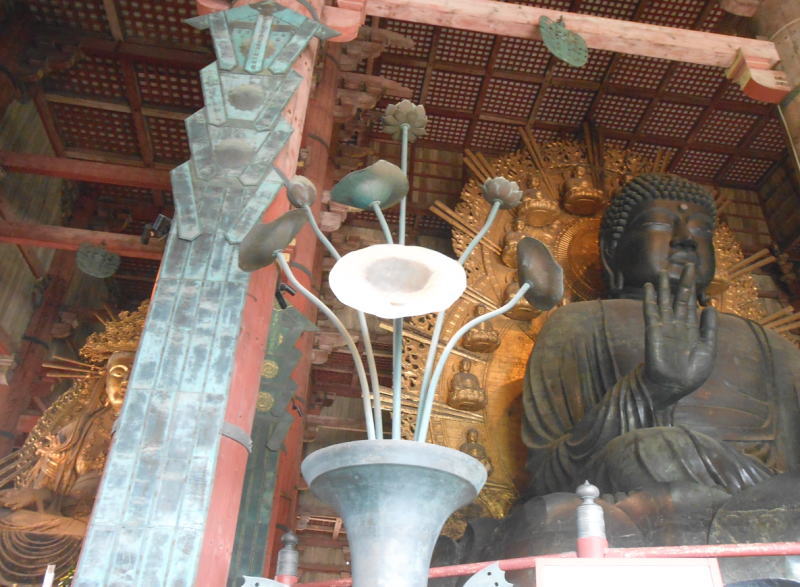Last update October 13, 2022
東大寺
Todaiji Temple (5)

|
災害・戦禍による被害の歴史

 天平時代には栄華を極めた東大寺だったんだけど、その後はいろんな災難があったのね。平安時代の斉衡(さいこう)2年(855年)には地震があって、大仏さんの頭が落っこっちゃったんだって。もう、罰当たりな地震ね。それで、これじゃいけないっていうことで、真如法親王(しんにょほうしんのう)っていう人が修復事業にあたって、貞観(じょうがん)3年(861年)に開眼供養を行ったらしいわ。その後も講堂などの建物が焼失したり、暴風雨によって南大門や大鐘楼が倒壊したりして、営繕事業が行われたのよ。
天平時代には栄華を極めた東大寺だったんだけど、その後はいろんな災難があったのね。平安時代の斉衡(さいこう)2年(855年)には地震があって、大仏さんの頭が落っこっちゃったんだって。もう、罰当たりな地震ね。それで、これじゃいけないっていうことで、真如法親王(しんにょほうしんのう)っていう人が修復事業にあたって、貞観(じょうがん)3年(861年)に開眼供養を行ったらしいわ。その後も講堂などの建物が焼失したり、暴風雨によって南大門や大鐘楼が倒壊したりして、営繕事業が行われたのよ。
でも、まだこれくらいならマシなほうよ。平安時代も終わりになると、源平抗争が起こって、その戦火で治承(じしょう)4年(1180年)12月には大仏殿をはじめとする伽藍の大部分が焼けてしまったんだって。もう、ほんとに戦争ってイヤあね!で、この翌年から、俊乗房重源(しゅんじょうぼうちょうげん)っていうお坊さんが中心になって復興造営が始められたのね。文治(ぶんじ)元年(1185)に大仏さまの開眼供養が行われて、建久(けんきゅう)6年(1195)には大仏殿落慶供養、さらに、建仁(けんにん)3年(1203)には東大寺総供養が行われて、やっと一安心ってところね。
ところが、鎌倉時代が終って室町時代の末になると、もう世は末というか、群雄割拠の時代。下の者が上の者を倒す、スズメがカラスを倒す(?)といった下克上の気運が満ちていたらしいわ。そして、また、永禄(えいろく)10年(1567)10月、東大寺の大伽藍(だいがらん)が灰になってしまったんだって。ほんとに人間って学習能力がないのかしら。せっかく復興したのにまた焼いちゃって。で、またぞろ、さっさと復興するのかなと思ったら、世は戦国時代。世相混沌、カオスそのもの。復興の余裕なんかなくってさ、大仏さんなんか、屋根がなくなっちゃったもんだから、頭の部分を銅板で補っただけで、「露座(ろざ)の大仏」なんて呼ばれてたらしいわ。
 それから、江戸時代になってやっと再建しようという動きが見られたわけ。龍松院公慶(りゅうしょういんこうけい)上人ってお坊さんが、徳川幕府に働きかけて再建造営にかかったのね。そして、焼失から100年以上も経って、やっと、元禄(げんろく)5年(1692年)に大仏さまの開眼供養、宝永(ほうえい)6年(1709年)に大仏殿の落慶供養が行われたのよ。でもね、伽藍の大きさは、前の約3分の2に縮小されてしまったのね。なんか、もったいないわよね。その後も、明治維新にいたるまで、整備再建が行われてだいたい今のようなたたずまいになったらしいわ。
それから、江戸時代になってやっと再建しようという動きが見られたわけ。龍松院公慶(りゅうしょういんこうけい)上人ってお坊さんが、徳川幕府に働きかけて再建造営にかかったのね。そして、焼失から100年以上も経って、やっと、元禄(げんろく)5年(1692年)に大仏さまの開眼供養、宝永(ほうえい)6年(1709年)に大仏殿の落慶供養が行われたのよ。でもね、伽藍の大きさは、前の約3分の2に縮小されてしまったのね。なんか、もったいないわよね。その後も、明治維新にいたるまで、整備再建が行われてだいたい今のようなたたずまいになったらしいわ。
その後、明治政府による「廃仏毀釈令(はいぶつきしゃくれい)」などが出されて、存続自体が危ぶまれたこともあったらしいわ。また壊そうってことかしら。人間って懲りないわねー。だけど、こういった危機も乗り越えて、明治と昭和に大きな大仏殿修理などもしながら、維持に努め、平成10年には「古都奈良の文化財」として世界文化遺産にも登録されたってわけ。めでたし、めでたし。
History of Survivals
The Tempyō Era (710 - 784) saw the temple's glorious days. However, as the period drew closer to the end, the temple began to slide into a long dark age. An earthquake in 855 hit the statue and ripped off its head. To repair the damage, a high priest called Shinnyo Hosshin-ō (Tathagata Dharma Prince) led the reconstruction project, which was completed in 861 by conducting the Eye-Opening Ceremony. But, soon a fire burned down the Assembly Hall and a storm destroyed the South Gate and the Big Belfry. Repair operations followed the disasters.
 At the end of the Heian Period (794 - 1192), the conflict between the Ghenji and the Heike Clans became intense. The warfare between the clans caused the destruction of major parts of the temple premises including the Buddha's Hall in December 1180. Shunjō Bōchōgen, a priest, started the restoration the following year, and the Eye-Opening Ceremony took place in 1185, followed by the cosecration of the Buddha's Hall in 1195, and the comprehensive consecration of the entire temple area in 1203.
At the end of the Heian Period (794 - 1192), the conflict between the Ghenji and the Heike Clans became intense. The warfare between the clans caused the destruction of major parts of the temple premises including the Buddha's Hall in December 1180. Shunjō Bōchōgen, a priest, started the restoration the following year, and the Eye-Opening Ceremony took place in 1185, followed by the cosecration of the Buddha's Hall in 1195, and the comprehensive consecration of the entire temple area in 1203.
In the latter part of the Muromachi Period (1338 - 1573), the society was in a chaotic state. The nation had lost its central power and divided into many warlord fractions fighting over the dominance. Drastic social changes were every day events: the lower echelon toppled the upper and took over their positions, reversing the hierarchical order. This spirit of upward move filled the society and a war situation was ubiquitous throughout Japan. In 1567, the temple complex was destroyed again, but this time there was no one who would dare to plan for a reconstruction project. The Buddha statue was left, for long time, in the hall remains with the roof ripped off, and dubbed as "a Buddha Sitting in a Roofless House".
A movement toward the reconstrution had to wait until the Edo Period (1603 - 1867), when the high priest Ryūshō-in Kōkei appealed to the Tokugawa shogunate to rebuild the temple. One hundred years after the last destruction, the restoration finally took place; the Eye-Opening Ceremony of the Buddha statue and the consecration of the Buddha's Hall were held in 1692 and 1709 respectively. The size of the temple complex was however, reduced to 2/3 of the original one. A series of repair and maintenance operations have been carried out since then up until today.
Later in the Meiji Period (1868 - 1912), the temple was once again at stake when the movement to abolish Buddhism occured, which, the temple managed to overcome.
Major repairs were performed on the Buddha's Hall in the Meiji and Shōwa (1926 - 1988) Periods to maintain the temple in good shape. In 1998, Tōdaiji Temple was registered as a World Cultural Heritage site and is highly valued as an asset in Nara, an ancient capital of Japan.




 天平時代には栄華を極めた東大寺だったんだけど、その後はいろんな災難があったのね。平安時代の斉衡(さいこう)2年(855年)には地震があって、大仏さんの頭が落っこっちゃったんだって。もう、罰当たりな地震ね。それで、これじゃいけないっていうことで、真如法親王(しんにょほうしんのう)っていう人が修復事業にあたって、貞観(じょうがん)3年(861年)に開眼供養を行ったらしいわ。その後も講堂などの建物が焼失したり、暴風雨によって南大門や大鐘楼が倒壊したりして、営繕事業が行われたのよ。
天平時代には栄華を極めた東大寺だったんだけど、その後はいろんな災難があったのね。平安時代の斉衡(さいこう)2年(855年)には地震があって、大仏さんの頭が落っこっちゃったんだって。もう、罰当たりな地震ね。それで、これじゃいけないっていうことで、真如法親王(しんにょほうしんのう)っていう人が修復事業にあたって、貞観(じょうがん)3年(861年)に開眼供養を行ったらしいわ。その後も講堂などの建物が焼失したり、暴風雨によって南大門や大鐘楼が倒壊したりして、営繕事業が行われたのよ。 それから、江戸時代になってやっと再建しようという動きが見られたわけ。龍松院公慶(りゅうしょういんこうけい)上人ってお坊さんが、徳川幕府に働きかけて再建造営にかかったのね。そして、焼失から100年以上も経って、やっと、元禄(げんろく)5年(1692年)に大仏さまの開眼供養、宝永(ほうえい)6年(1709年)に大仏殿の落慶供養が行われたのよ。でもね、伽藍の大きさは、前の約3分の2に縮小されてしまったのね。なんか、もったいないわよね。その後も、明治維新にいたるまで、整備再建が行われてだいたい今のようなたたずまいになったらしいわ。
それから、江戸時代になってやっと再建しようという動きが見られたわけ。龍松院公慶(りゅうしょういんこうけい)上人ってお坊さんが、徳川幕府に働きかけて再建造営にかかったのね。そして、焼失から100年以上も経って、やっと、元禄(げんろく)5年(1692年)に大仏さまの開眼供養、宝永(ほうえい)6年(1709年)に大仏殿の落慶供養が行われたのよ。でもね、伽藍の大きさは、前の約3分の2に縮小されてしまったのね。なんか、もったいないわよね。その後も、明治維新にいたるまで、整備再建が行われてだいたい今のようなたたずまいになったらしいわ。 At the end of the
At the end of the 